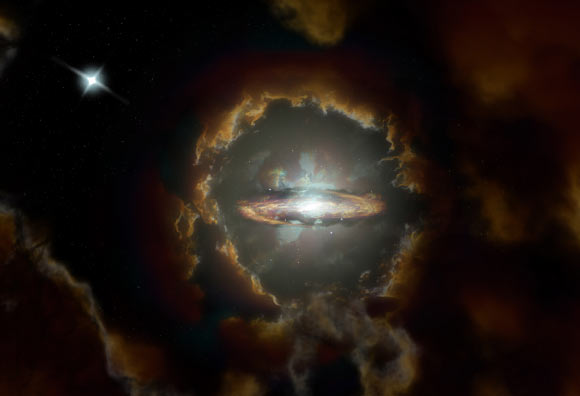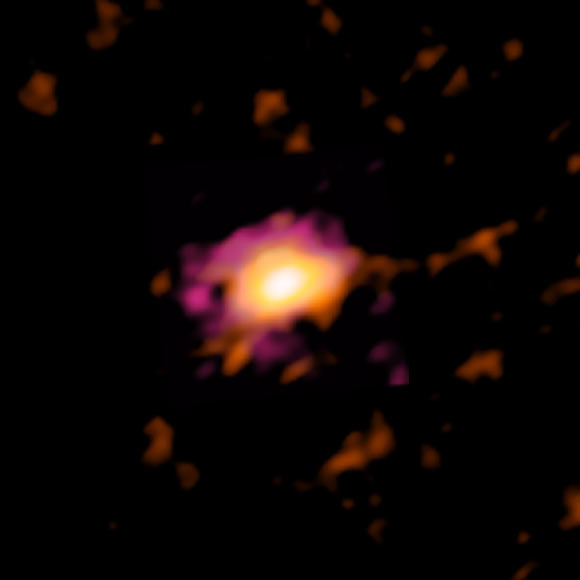Astronomers using the Atacama Large Millimeter/submillimeter Array (ALMA) have found evidence for the most distant rotationally supported disk galaxy ever detected. Designated DLA0817g, the galaxy is seen as it they existed only 1.5 billion years after the Big Bang.

An artist’s impression of DLA0817g (Wolfe Disk), a massive, rotating disk galaxy in the early, dusty Universe. The galaxy was initially discovered when ALMA examined the light from a more distant quasar (top left). Image credit: NRAO / AUI / NSF / S. Dagnello.
DLA0817g, nicknamed the Wolfe Disk after the astronomer Arthur M. Wolfe, was identified when ALMA examined the light from a more distant quasar.
“While previous studies hinted at the existence of these early rotating gas-rich disk galaxies, thanks to ALMA we now have unambiguous evidence that they occur as early as 1.5 billion years after the Big Bang,” said Dr. Marcel Neeleman, an astronomer at the Max Planck Institute for Astronomy.
Dr. Neeleman and colleagues found that DLA0817g rotates with a velocity of about 272 km per second (170 miles per second), similar to our Milky Way Galaxy.
The astronomers also used NSF’s Karl G. Jansky Very Large Array (VLA) and the NASA/ESA Hubble Space Telescope to learn more about star formation in the galaxy.
“The star formation rate in the Wolfe Disk is at least 10 times higher than in our own Galaxy,” said Dr. J. Xavier Prochaska, an astronomer at the University of California, Santa Cruz.
“It must be one of the most productive disk galaxies in the early Universe.”

ALMA radio image DLA0817g (Wolfe Disk), seen when the Universe was only 10% of its current age. Image credit: ALMA / ESO / NAOJ / NRAO / M. Neeleman / AUI / NSF / S. Dagnello.
The discovery of DLA0817g provides a challenge for many galaxy formation simulations, which predict that massive galaxies in the early Universe grew through many mergers of smaller galaxies and hot clumps of gas.
“Most galaxies that we find early in the Universe look like train wrecks because they underwent consistent and often violent merging,” Dr. Neeleman said.
“These hot mergers make it difficult to form well-ordered, cold rotating disks like we observe in our present Universe.”
In most galaxy formation scenarios, galaxies only start to show a well-formed disk around 6 billion years after the Big Bang.
The fact that the team found such a disk galaxy when the Universe was only 10% of its current age, indicates that other growth processes must have dominated.
“We think the Wolfe Disk has grown primarily through the steady accretion of cold gas,” Dr. Prochaska said.
“Still, one of the questions that remains is how to assemble such a large gas mass while maintaining a relatively stable, rotating disk.”
The discovery is reported in a paper in the journal Nature.
_____
M. Neeleman et al. 2020. A cold, massive, rotating disk galaxy 1.5 billion years after the Big Bang. Nature 581, 269-272; doi: 10.1038/s41586-020-2276-y







